In Japanese, doujin 同人, meaning literally "same people," refers to people who have the same hobby as you. In anime and manga, doujin refers to indie manga, anime, games, etc., and their creation, as opposed to mainstream works.
The word doujin is also romanized douzin, dōjin, or dōzin.
Meaning
Literally, doujin means "same people," "same person," onaji hito 同じ人. From there, it refers to someone who shares the same hobby as you, the same sort of person.
In Japanese, an otaku オタク is a "nerd," or "geek," referring to someone who enjoys a hobby, such as anime, i.e. an otaku is an "anime fan." If two otaku share the same hobby, they are doujin.
- onaji shumi
同じ趣味
Same likes.
Same hobby.
Such otaku will have an anime they like and sometimes create derivative works featuring characters from that anime, such as fan fiction (known as SS, short stories), fanzines, and in some cases whole animations or games featuring characters whose copyright is owned by someone else.
- The webcomic Awkward Zombie is a prime example of this, featuring hundreds of comics with characters from all sorts of games the author has played.
- The website Newgrounds has (once flash) animation and games uploaded by users, many of which feature characters some series or game.
People who like this sort of content end up being otaku, too, after all, if you make a comic about a certain game, it makes sense that only people who have played that game will understand what the comic is really saying, and who the characters are.
- Context: in a preview video for the then unreleased video game New Super Mario Bros. U Deluxe, for the Nintendo Switch, an item called a Super Crown was used to turn a character, Toad, into a princess, called Toadette. Before the game was released, a comic was made by a fan using Mario Bros. characters featuring the Super Crown turning Bowser into what became known as Bowsette, and spawning countless memes following the same idea.
This means an otaku makes content for similar-minded otaku, so it's made by doujin, for doujin.
As a consequence, the term doujin started being used to refer to the stuff created by fans, and the creation of such stuff, rather than to refer to the people themselves.(dic.pixiv.net)
That is, if you have a company that publishes a monthly manga magazine, with professional manga artists on its payroll, the published product isn't a doujin, but if one of those artists draws a manga in their free time to publish it independently, that's then called a doujin.
- mangaka
漫画家
Someone who makes manga. A manga artist. - doujinka
同人家
Someone who makes doujin. A doujin artist. - manga zasshi
漫画雑誌
Manga magazine. - doujinshi
同人誌
A doujin magazine. A doujin comic.
- Context: Fukuda Shinta 福田真太 warns fellow manga artist Niizuma Eiji 新妻エイジ.
- Niidzuma-kun wa puro toshite no jikaku ga nasa-sugiru
新妻くんはプロとしての自覚がなさ過ぎる
Niizuma-kun, [you] lack self-awareness as a professional too much. (literally.)
- {jibun ga tanoshiku kakitai} dake nara doujinshi demo kaitereba ii
自分が楽しくて描きたいだけなら同人誌でも書いてればいい
If [you] only {want to draw having fun} then [you] should just draw a doujinshi. - shikashi {"Janpu" de kaku} puro nanda
しかし「ジャンプ」で描くプロなんだ
But [you] are a professional [who] {draws at Jump}.- Jump is the name of a shounen manga magazine.
- 「」 - quotation marks.
- {dokusha wo tanoshimaseru} koto wo dai-ichi ni kangaenakereba dame da
読者を楽しませる事を第一に考えなければダメだ
[You] have to make {entertaining readers} the number one [priority].- In other words, a doujin draws doujinshi to entertain to entertain themselves, while a professional draws manga to entertain the audience.
Market
The doujin can be sold in various ways.
There are events, conventions, centered at all sorts of anime-related themes, and sometimes at specific works, in which an artist may sell their work at stalls for convention-goers.
- The largest one is the Comiket コミケット. It's called by different names depending on season: the one held in winter is called fuyukomi 冬コミ, the one held in summer is called natsukomi 夏コミ.
There are also several websites in which authors can sell their work online, either as a physical copy or for download. For example: Pixiv, Toranoana, DLSite.
Although the same isn't as true for the modern, digital doujin, older doujin can easily become a rarity or get lost forever in time. After all, it's not like there were tends of thousands of copies made by a company, but only around a hundred copies made by the doujin's creator.
The doujin may never get a reprint, the author may lose the means to reprint it, or simply not bother with it anymore for one reason or another.
Circle
A "circle," saakuru サークル, is a group of people engaged in some sort of hobbyist activity, such as swimming, or photography, or drawing manga. A doujin circle is group whose purpose is to make doujin.
- saakuru katsudou
サークル活動
Circle activities, e.g. drawing manga. - doujin katsudou
同人活動
Doujin activities, e.g. drawing manga.
A doujin is typically published under the name of a circle. This means there's the title of the doujin, the name of the circle, and the name of the authors that are part of the circle, which are typically pseudonyms (pen names), and not their real names.
Also, a same artist may be part of different circles, publishing some works as one circle, and other works as another circle.
Although the term typically refers to a group of people, since a doujin is associated with a circle, there are also circles composed of only one person, who does the drawing, writing, etc. This would be called a:
- kojin saakuru
個人サークル
Individual circle
Types
There are various types of doujin.
- doujinshi
同人誌
A doujin magazine. Typically comics, manga. - doujin komikku
同人コミック
Comic series. - doujin shousetsu
同人小説
Novels. Stories. - doujin ongaku
同人音楽
Music. - doujin geemu
同人ゲーム
Game. Video-game. Computer game. - doujin anime
同時アニメ
Animation. - doujin sofuto
同人ソフト
Software. Includes games
Although anything can be created by doujin, since we're talking about the work of a few creators on their free time, with a very limited budget, these don't really compare in scale to the work of industry professionals.
In particular, anime and games are products that require several talents to create. It's not the sort of endeavor a person can normally undertake alone.
Anime
A doujin anime tends to be very few episodes and very short compared to the typical 12 episode, 20 minute each length common in television. Such anime requires drawn characters, backgrounds, music, voice acting, post-production, etc., so it's the work of a considerably large circle.
- Eizouken ni wa Te wo Dasu na! 映像研には手を出すな! is an anime about the effort it takes to create a doujin anime.
- SHIROBAKO is an anime about creating an anime in a professional anime studio.
If a doujinshi gets an "anime adaptation," anime-ka アニメ化, then it's unlikely that it will have enough content to air on TV, even if done by a professional studio.
If the anime is sold as physical discs on a convention, then it's called an OAV. If it's streamed online instead, then it's called an ONA.
For example, there's a doujin anime that adapts the doujin game Touhou 東方, subtitled Musou Kakyou 夢想夏郷, that was sold on Comiket as discs, making it an OVA.
There's also been a comic series posted on Twitter called Getsuyoubi no Tawawa 月曜日のたわわ that got an anime adaptation streamed online, making its anime an ONA.
Games
Games also multiple talents, but particularly essential is the ability to program, which means a typical indie game will have at least one person in charge of programming and one person in charge of artwork.
- Stardew Valley is exceptionally created by a single person, who did the programming, pixel art, and music.(gamasutra.com)
- As far as I know, that person isn't human. He's a robot, or deity. Don't trust him.
In order to make the doujin game creation endeavor more realistic to hobbyists, all sorts of software have been created to facilitate the various aspects of it. Notable examples include:
- RPGMaker, Aru-pii-jii Tsukuuru RPGツクール, which makes it very easy to create a very specific type of 2D JRPG similar to Dragon Quest, in which characters walk around a top-down map, and battles with monsters occur in a separate screen. Originally based on Ruby, later versions use Javascript.
- Renpy, a free and open-source Python-based visual novel engine with its own scripting language and native support for both ADV and NVL modes.
- Unity, a development platform to create 3D and 2D games, a free version that doesn't let you remove the Unity splash screen is available for low revenue projects.
- Game Maker, a game development platform with low cost yearly license.
Thankfully, doujin, meaning people of same hobby, would love to see more people participating in their hobby, so several creators all across the internet offer part of their work for free for use in doujin games, so long as they're credited for the inclusion.
Such work ranges from sprites, to sound effects, to music, and even scripts, libraries and plugins for specific software.
- Yanfly is a well-known creator of dozens of RPGMaker plugins.
vs. Parody
A lot of doujin are parodies and derivative work—fans of an anime, drawing comics of characters of the anime they like—however, not all of them are parodies, sometimes, a doujinshi is simply an indie publication featuring only original characters.
- aniparo
アニパロ
Anime parody. Term for doujinshi that parodies anime.- niji sousaku
二次創作
Derivative work.
- niji sousaku
- orihon
オリ本
Original book. Term for doujinshi with original characters.- orijinaru
オリジナル
Original.
- orijinaru
- Context: Tsunashi Youta 十陽太 talks about tht doujinshi he has to make.
- sessha kakeru anija kapu no orihon de gozaru!!
拙者×兄者カプのオリ本でござる!!
[It] is an orihon with me × [my] older brother as couple!!- Note: using sessha 拙者 as first person pronoun and ending one's sentences with de gozaru でござる are things only samurai characters and otaku do, and this is no samurai.
- Couples are described as A × B are typically ordered as seme × uke 攻め×受け, which means Youta's older brother would be the uke in his doujinshi.
- komike mo chikai shi, ganbaraneba!!
コミケも近いし頑張らねば!!
The comiket is soon, too, so [I] have to work hard!! - orihon: {tokutei no sakuhin wo daizai to shita} niji-sousaku dewanaku, orijinaru no naiyou no hon (ikooru doujinshi).
オリほん[おりほん]:特定の作品を題材とした2次創作ではなく、オリジナルの内容の本(=同人誌)。
orihon: not a derivative work [that] {makes as theme a certain work}, a book of original content (= doujinshi).
vs. Hentai
The difference between doujin and hentai 変態, which, in English, refers to pornographic manga and anime, but in Japanese means "pervert," is that they're completely separate things: not all doujin are hentai and not all hentai are doujin.
Photo source: やまひで's blog, 同人ゲーム「地主一派 電車でD LightningStage」で遊んでみた - type-y.com, accessed 2019-01-09.
- Context: a doujinshi parodying the series Initial D, which is about car racing and drifting, except featuring trains racing and drifting instead.
- fukusen dorifuto!!
複線ドリフト!!
Multi-track drifting!!
The reason for this association is simply that there isn't a lot of motivation to create a derivative work that's nothing more than the work it originates from.
In a serialized manga, there's a publisher and an editorial, which can veto creative decisions of the author and have some control over the creative work.
This can range from all sorts of things, e.g. the target audience is children, so drawing characters smoking or drinking alcohol is NG, you can't draw that. Besides censorship, it makes sense that all sorts of situations wouldn't fit the story, for plot or commercial reasons.
Most series will not feature male characters in a gay relationship. This creates a vacuum that's later filled by fans, the fujoshi 腐女子, "rotten girls," who create BL fanfiction featuring characters in gay relationships.
Right: Harry Potter
Anime: Asobi Asobase あそびあそばせ (Episode 4)
- Context: a typical ship.
The same also happens with lesbian shipping, yuri 百合.
With pornography, it's no different.
If it exists, there's porn of it.
—Rule 34 of the internet.
The fact that the series isn't erotic motivates fans to make it erotic in fan art in order to fill a vacuum.
Conversely, if a series is supposed to be erotic, i.e. it's of the ecchi エッチ genre, it tends not have erotic fan art made out of it, because fan artists don't feel motivated to do something that was already done in the series.
The doujin is more interested in building upon the original work than simply copying it. It's because it wasn't done in the series that fans want to create it themselves.
- Context: Nozaki played a dating sim, in which the player's best friend, Tomoda 友田, kept helping the player in his romantic conquests in various ways, with hints, and free movie tickets. Moved by this, Nozaki decides to spend the night drawing a fan comic featuring Tomoda with a romantic partner, arriving to the conclusion he's more interesting in the player than in any of the girls. In the next day, a girl finds the comic drawn.
- manga...
マンガ・・・
A comic... - juuni-nin no bishoujo yori mo omae ga suki nanda!!
12人の美少女よりもお前が好きなんだ!!
[I] like you more than the twelve bishoujo!!- Each "beautiful girl" you can conquest in a dating sim is a bishoujo.
- Tomoda!!!
友田!!! - sonna...!!!
そんな・・・!!! - ore wa... mi-mamotteru dake de... yokatta noni...
俺は・・・見守っるだけで・・・良かったのに・・・
I'd be [happy] with just watching over [you]... - poro...
ポロ・・・
*tear falling*
Unfortunately, this ends up leading some doujin to feature bad ends, which is sometimes target of critique by fans.
Since in a mainstream series the hero lives happily forever after with the heroine, and the heroine is always saved from the villains by the hero, and the hero side always wins, a doujin attempting to create something different results in the hero side being defeated, and everything ending badly, like:
- aku-ochi
悪堕ち
Falling to evil.- When a good character changes side to evil, e.g. by "brainwashing," sen'nou 洗脳.
- See also: womb tattoo.
- netorare
寝取られ
Sleep-taken. (literally.)
- When someone's girlfriend, wife, etc. sleeps with another guy, i.e. the other guy "takes" his girl, by sleeping with her.
エロ同人
The word ero doujin エロ同人 refers to a pornographic doujin. It's a way to say hentai doujin in Japanese.
- Context: Akizuki Kouyou 秋月紅葉 warns Kanzaki Hideri 神崎ひでり about Amano Miu 天野美雨.
- {ki wo tsukenee} to ero-doujin no neta ni tsukawareru zo
気をつけねーとエロ同人のネタに使われるぞ
If {[you] don't take care} [you] will be used as material for an ero-doujin.
- tsukawareru - passive form of tsukau 使う, "to use."
- neta ネタ - "material" used as base for a news article or fiction story.
- Akidzuki-san, watashi no kokoro wo yomimashita ne
秋月さん 私の心を読みましたね
Akizuki-san, [you] read my [mind], [didn't you].
薄い本
An usui-hon 薄い本, meaning "thin book," is term for pornographic doujinshi. They're so called because doujinshi are thin, usually twenty–thirty pages, the length of one chapter, or rather, an one-shot story, compared to the thickness of a monthly edition of a magazine or a whole volume of a manga.
Sometimes, a circle publishes a collection of stories previously published as usui-hon into a single volume. Such volume is called a tankoubon 単行本, also known as a "tank" in English.
There are other sorts of tankoubons. For example, if several circles contribute each with one story in a tankoubon, that's an anthology アンソロジー.
References
- 同人 - dic.pixiv.net, accessed 2021-05-12.
- The 4 years of self-imposed crunch that went into Stardew Valley - gamasutra.com, accessed 2021-05-12.
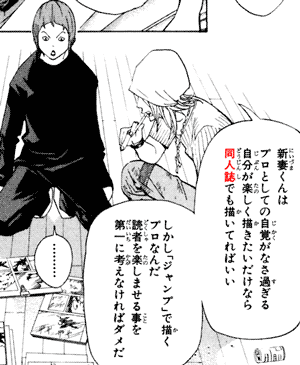

![拙者×兄者カプのオリ本でござる!! コミケも近いし頑張らねば!! オリほん[おりほん]:特定の作品を題材とした2次創作ではなく、オリジナルの内容の本(=同人誌)。](https://media.japanesewithanime.com/uploads/orihon-danna-ga-ch04.png)
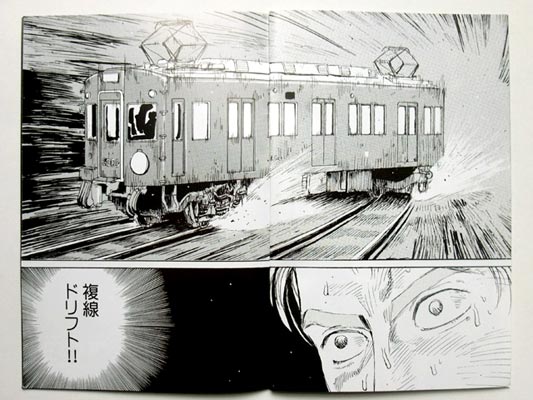
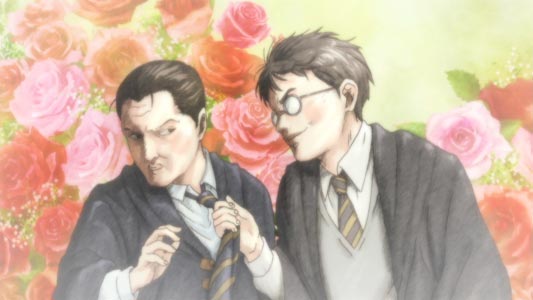
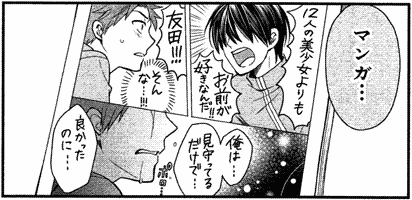
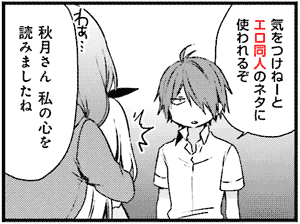
No comments: